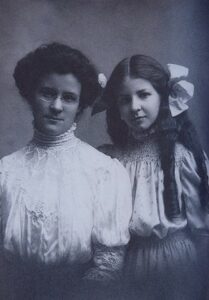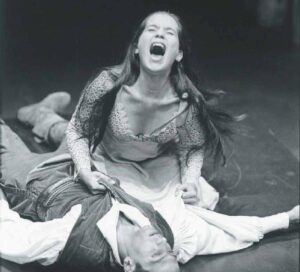by Debbie Burke
In recent TKZ posts, Myers-Briggs has been mentioned by John Gilstrap and TKZ regular Eric Beversluis. Kathryn Lilley also talked about Myers-Briggs in this post from 2015.
Which brings me to today’s discussion about how authors can use this personality test to build characters and foment conflict.
Have you ever met someone and instantly disliked them for no apparent reason?
Conversely, have you ever “clicked” with a stranger and didn’t know why?
Have you ever been fired from a job or had to leave because of “personality conflicts”?
Have you ended a relationship or been dumped because of different values?
Do you have a hard time figuring out the needs, desires, and priorities (or lack thereof) of some people?
Do people sometimes act in ways you can’t understand or justify?
How about your characters? Do they struggle with the above issues?
If so, that’s great because conflict is the mainstay of fiction.
Myers-Briggs (MB) is a tool that can help writers answer these questions.
In 1923, the mother/daughter team of Katharine Cook Briggs (1875-1968) and Isabel Briggs Myers (1897-1980) became interested in the study of personality types based on research by Swiss psychiatrist Carl Jung (1875-1961). The two women developed the Myers-Briggs Type Indicator test that classifies the different ways people function in life.
Their purpose was to help people make career and personal choices that best suited their individual personalities. The test has been widely used by psychologists and industry to put people in the right jobs based on their particular traits, as well as to improve communication between vastly different personalities.
In other words, to solve problems.
However, in fiction, writers want to create problems for their characters.
If you understand why certain MB personality types clash with other types, you can use that knowledge to increase tension among your characters.
With the MB test, let’s dig a little deeper into reasons why you instantly dislike a person or can’t understand why they act the way they do. Then we’ll extrapolate those reasons into opportunities to create conflict among characters.
What are the MB components?
Introvert/Extravert (I or E)
Are you shy among strangers? Do you prefer to be alone in an interior world of thoughts and ideas? If so, you may be an introvert (I).
Are you outgoing and like large groups of people? Are you interested in what’s happening in the big, wide world around you? If so, you’re likely an extravert (E).
What happens if you take “I,” a shy character who avoids conflict at all costs, and force him/her to interact with “E,” a bold, boisterous character who loves to scrap?
Intuitive/Sensing (N or S)
Do you draw conclusions based on hunches? Do you look below the surface to determine what is going on? If so, you’re probably intuitive (N).
Do you use your five senses (sight, hearing, smell, taste, and touch) to observe the world around you? Do you like facts and figures? You might be sensing (S).
Take “S,” a detective with the attitude if-I-can’t-see-it-it-doesn’t-exist. Add “N,” an intuitive who plays hunches and follows his/her gut instinct. Partner those two up and watch the fireworks.
Thinking/Feeling (T or F)
Are you logical and fact-oriented? You’re probably thinking (T).
Are you in touch with emotions and driven by them? You’re probably feeling (F).
Arrange a date between “T,” a logical, analytical woman, and “F,” a warm-fuzzy metrosexual. Lots of problems for that romance.
Judging/Perceiving (J or P)
Are you decisive and want things settled, organized, and clearly defined? Probably judging (J).
Do you prefer to take things as they come, remaining open to new opportunities? Probably perceiving (P).
The Odd Couple is the classic example of conflict between “J” and “P”. Felix demands neatness and precision while Oscar thrives on disorder and chaos. Remember this scene: “It’s not spaghetti, it’s linguine.”
Sixteen Variations:
The combinations of the above characteristics yield sixteen variations of personality types. If you’re not already familiar with MB types, here is a link that describes each one: https://www.myersbriggs.org/my-mbti-personality-type/mbti-basics/the-16-mbti-types.htm
Pitting Opposites Against Each Other:
If you instantly dislike someone when you first meet them, their four dominant traits may be the opposite of your four dominant traits. This doesn’t mean they’re right or wrong; they’re simply different ways in which you perceive the world around you.
Here are a few examples to build personality differences into fictional conflict.
An extravert “E” can’t understand why the introvert “I” wants to stay home rather than go out partying. “I” is sick and tired of being pressured to mingle with other people when s/he would much rather read a book.
A sensing “S” doesn’t see why an intuitive “N” doesn’t act on facts that are as plain as the nose on your face. “N” trusts flashes of insight from the subconscious and thinks “S” is hopelessly unimaginative and dull.
A thinking “T” has no patience for a feeling “F” who always gets upset over the stupidest things. “F” is constantly frustrated by “T” who never understands his/her feelings.
A judging “J” is fed up with that loosey-goosey perceiver “P” who never plans ahead and flops haphazardly from one activity to another. “P” is annoyed that “J” is so rigid, inflexible, and set in his/her habits.
Characters who are too much alike can also mean trouble:
If characters share the same traits, they may lack balance and believe that is the only way to be.
For instance, judgmental J extremists convince their followers to condemn anyone who doesn’t share their beliefs. This manifestation brought Hitler to power.
Feeling F characters can go overboard emotionally. Because of intense feelings, poor Romeo and Juliet both end up dead.
Characters can also be defined by their lack of a trait. A classic example is Star Trek’s Mr. Spock, an extreme “T” for whom logic is the supreme law. Whenever he was confronted by another character’s emotional “F” reaction, his response was: “That’s illogical.”
Personality traits run along a continuum. Some traits are well-developed and dominant; others are more subtle. Our job as writers is to combine dominant and subtle variations into unique characters who are not stereotypes.
The opposite qualities may be fairly equally developed in the same personality. For instance, when I took the MB as a teenager, the result was INTP but T and F scores were almost equal, meaning I possessed an analytical, logical mindset (my husband would dispute that!) but was also highly emotional (that, he agrees with!).
My Intuition N was well developed while my Sensing S scored low. That explains why I rarely notice someone’s eye color, clothes, or shoes, yet I know the depths of their fears and secrets.
Underdeveloped S makes me a lousy eyewitness. What was the bank robber wearing? Huh? What did the getaway car look like? I dunno.
Dominant traits can change with time and experience, giving your characters an opportunity to transform themselves.
As a child, I was extremely introverted and shy. Due to career requirements, my extraverted side developed because I had to deal with people. Now, I’m no longer paralyzed with dread at a party. In fact, I thoroughly enjoy meeting new people at writers’ gatherings and book festivals.
Not surprisingly, many writers fall into INFJ or INFP, a pattern Tom Kuegler explores in this article on medium.com.
Try guessing the traits of your mate and your children; that obnoxious neighbor you don’t get along with; your annoying boss.
You might gain insight into why they act the way they do.
Then put your characters through the MB personality type test and use their traits to increase conflict among them.
~~~
Now it’s your turn, TKZers.
Using MB traits, which category does your favorite fictional character fall into?
Who is the most memorable (not necessarily likable) character you can think of? Can you guess their category?
How do their traits cause conflict with other characters?
~~~
In Debbie Burke’s thriller, Instrument of the Devil, find out how the attraction between two INFP characters means trouble, while an ENTJ causes further complications.
Instrument of the Devil is on sale for $.99 during April. Here’s the link.





Most of my writer friends who have taken the test are INFJs. I am, as well. I like to throw in what some call the “wolf pack theory” into the mix– alpha, beta, and gamma. Most writers are gammas. We are the observers who can be an alpha or a beta when needed, but we prefer to sit and take note of what everyone else is doing instead of taking action ourselves.
I am more intuitive myself in creating characters. I have always had an idea or a theme for a novel, then I build my characters to fit it. Using the M-B or Tarot or whatever schematic of character is just too analytical.
Those friends and I all started in writing romance. I’m curious if the mystery writers here fall elsewhere on the M-B scale.
“Wolf pack theory” – hadn’t heard of that before. Sounds like fun.
I also create characters intuitively and often reverse engineer them. MB is just another fun tool in the toolbox that might help a stuck writer looking to build a character.
Good question whether mystery writers fall into similar MB slots as romance writers?
Thanks for chiming in, Marilynn.
Interestingly enough, my romance writing group did a workshop on this last month. We found out our own MB-type (I was an INFJ), but I went a step further. I did that for all of my main characters, contagonists, and antagonists.
What struck me as odd was all of my male protagonists are introverted thinkers and all of my female protagonists are extroverted sensing feelers. Of course, this is romance with mystery/suspense thrown in, so there has to be some conflict somewhere! I just thought it was odd that when I wrote them down, this pattern seemed to emerge.
We also had a look at natal charts, motivations in each generation from the Silent Generation to Millennials (which is *really* hard when you write futuristic urban fantasy), and the 4 temperments. I found it fascinating how each of those can cause conflicts between people, and how different types of people cope with different aspects of their lives, like technology, relationships, intimacy, work ethic, etc. I generally don’t give much thought to MBTI or personality quizzes or the like, because we’re all different depending on where we are that day or that year or that decade.
However, I find them helpful when I’m stuck as a writer and how to generate conflict by pitting one type against another, or one star sign against another. Ever seen a Taurus and a Libra get together? It’s pretty messy (according to the star signs anyway).
Even those silly Buzzfeed-esque quizzes like “what kind of potato are you” can give you a pretty good insight into a character and how they’d react. I am, apparently, a scalloped potato- fancy on the outside, regular girl underneath it all.
Mollie, that sounds like a fun workshop!
Interesting that you found such a consistent type pattern with your characters. Have you ever tried flipping them to create an IT woman and an ESF man? Might be an interesting exercise.
Any test, chart, or vegetable type that gets the imagination working is helpful. They all encourage creativity.
P.S. The era in which people are raised exerts a huge influence on their character. Wars, depressions, even prosperity imprint certain values that can last a lifetime.
I’m another INFJ writer. There might be something to the theory that writers are usually INFJ or INFP. Although, I take the whole thing with a grain of salt. It definitely has its flaws, for example, I react emotionally, but I make decisions logically. This is usually how people end up with a fairly even split between thinking and feeling.
However, it is a useful tool for creating a cast of characters that are distinct from each other. Too often I’ve read books and I’ve lost track of who’s who because there is nothing distinctive about the secondary characters, they’re just props to move the story along.
A tip I got somewhere to help figure out your own or a character’s MBTI was to look at the list of weaknesses associated with that type. People are usually more aware of their weaknesses than their strengths and it is where you’ll find your character’s flaws and the seeds for conflict with other characters.
I would also recommend looking up the Enneagram personality test. It has nine different basic types. It sounds too limited, but those nine types will have ‘a wing’ which means it is influenced by the type either side of it. Most INFJs are fours. They will either be influenced by three or five. Then there are nine levels of development from unhealthy to healthy. Here is a link to a website to find out more: https://www.enneagraminstitute.com/type-descriptions/
The Enneagram is more blunt and less of a ‘pat on the head’ than the MBTI. You’ll know you have figured out your type when it makes you squirm to read it. I use it when creating my characters as well. It is definitely worth a read.
Glad you brought up the Enneagram. It carries each personality type through its whole range from the best possible to the worst possible ramifications. Another really useful tool for character building. Thanks, Kate!
Seems I am an ENTP adrift in an INFJ world . . . ?
Worry not, John. According to MB’s table of data collected between 1972 and 2002, ENTPs make up 3.2% of the population. The rarest type is INFJ at 1.5% (ENTJ a close second at 1.8%).
Most prevalent types are ISFJ at 13.8% and ESFJ at 12.3%.
For more geeky statistical details, here’s the link: https://www.myersbriggs.org/my-mbti-personality-type/my-mbti-results/how-frequent-is-my-type.htm
Warning: you’ll need reading glasses and maybe a magnifying glass!
Pingback: Author Inspiration and This Week’s Writing Links – Staci Troilo